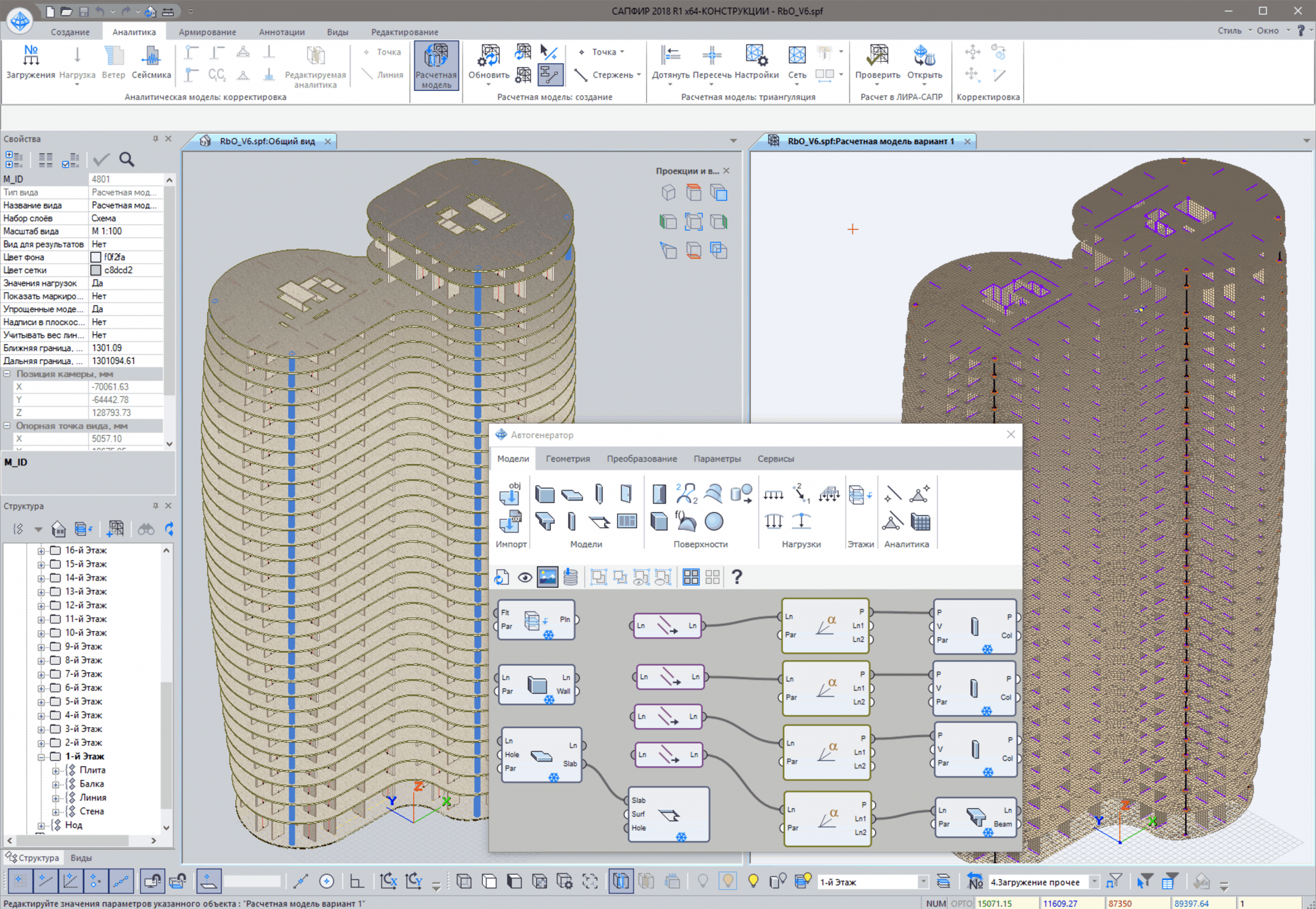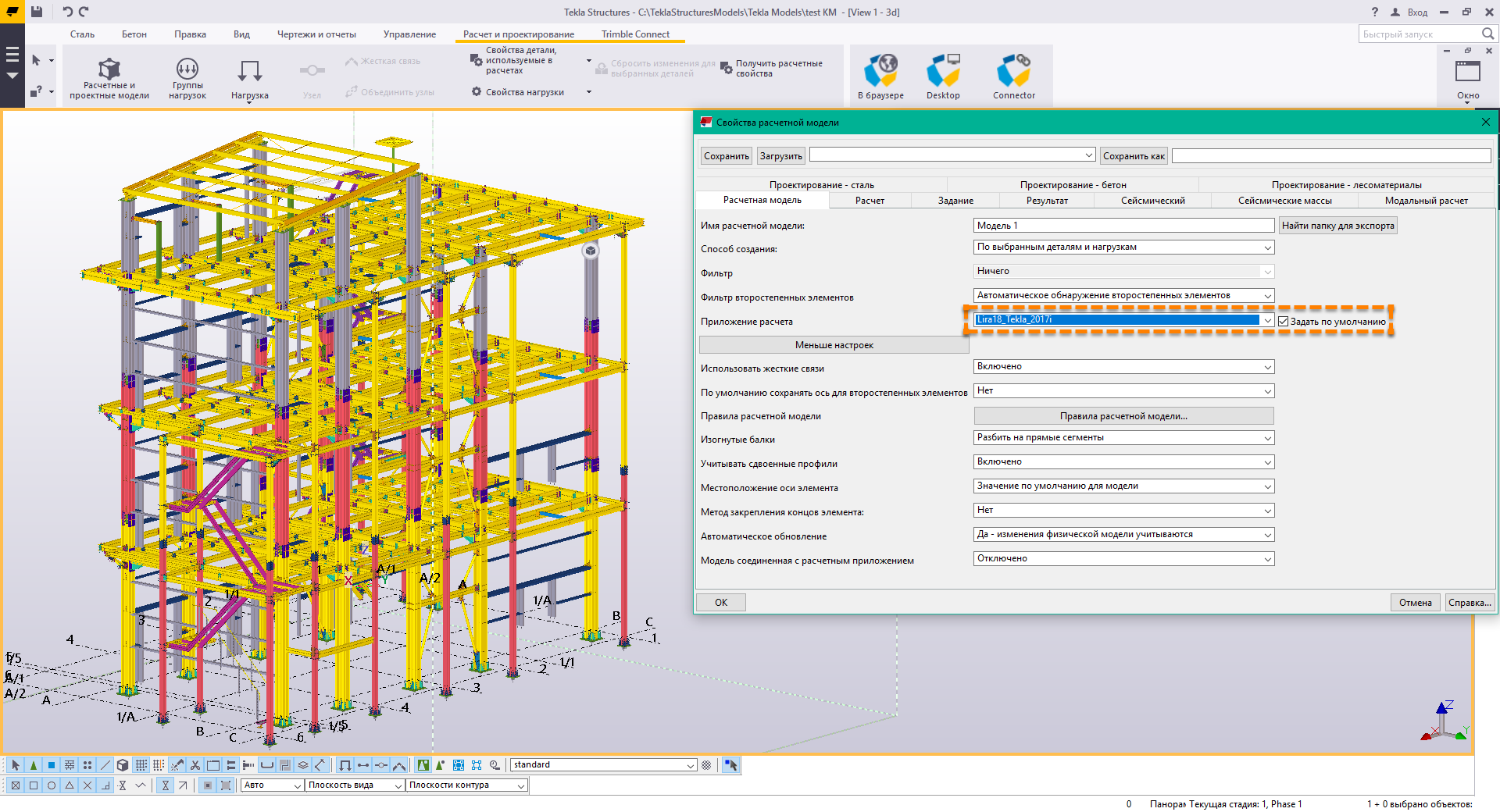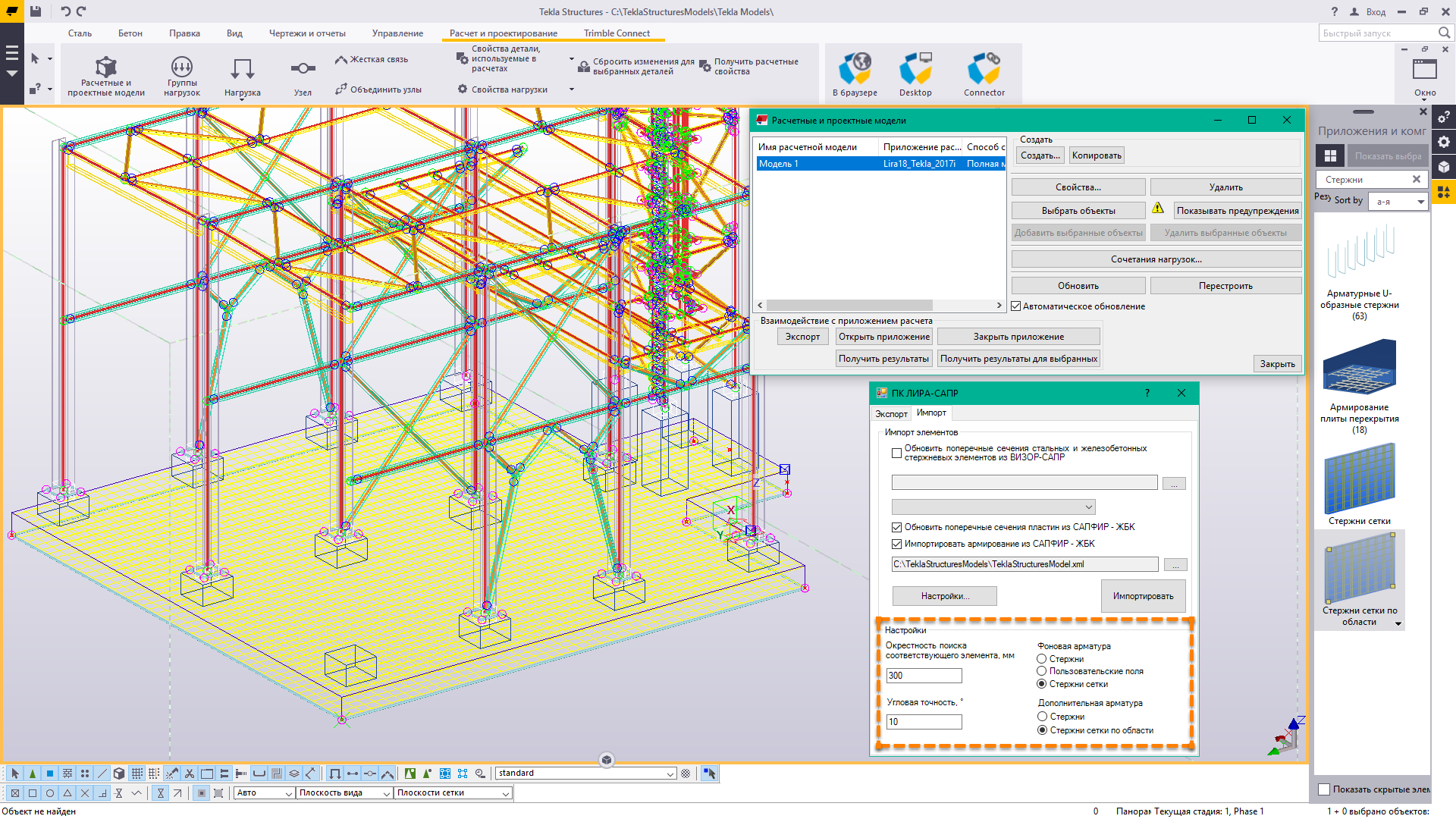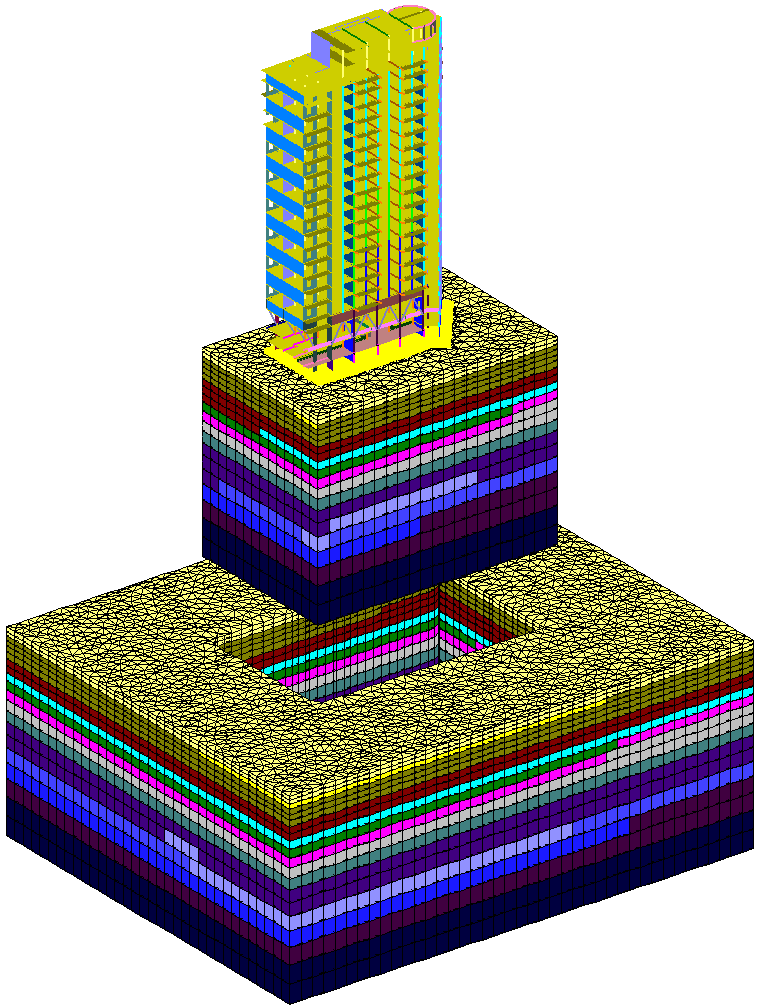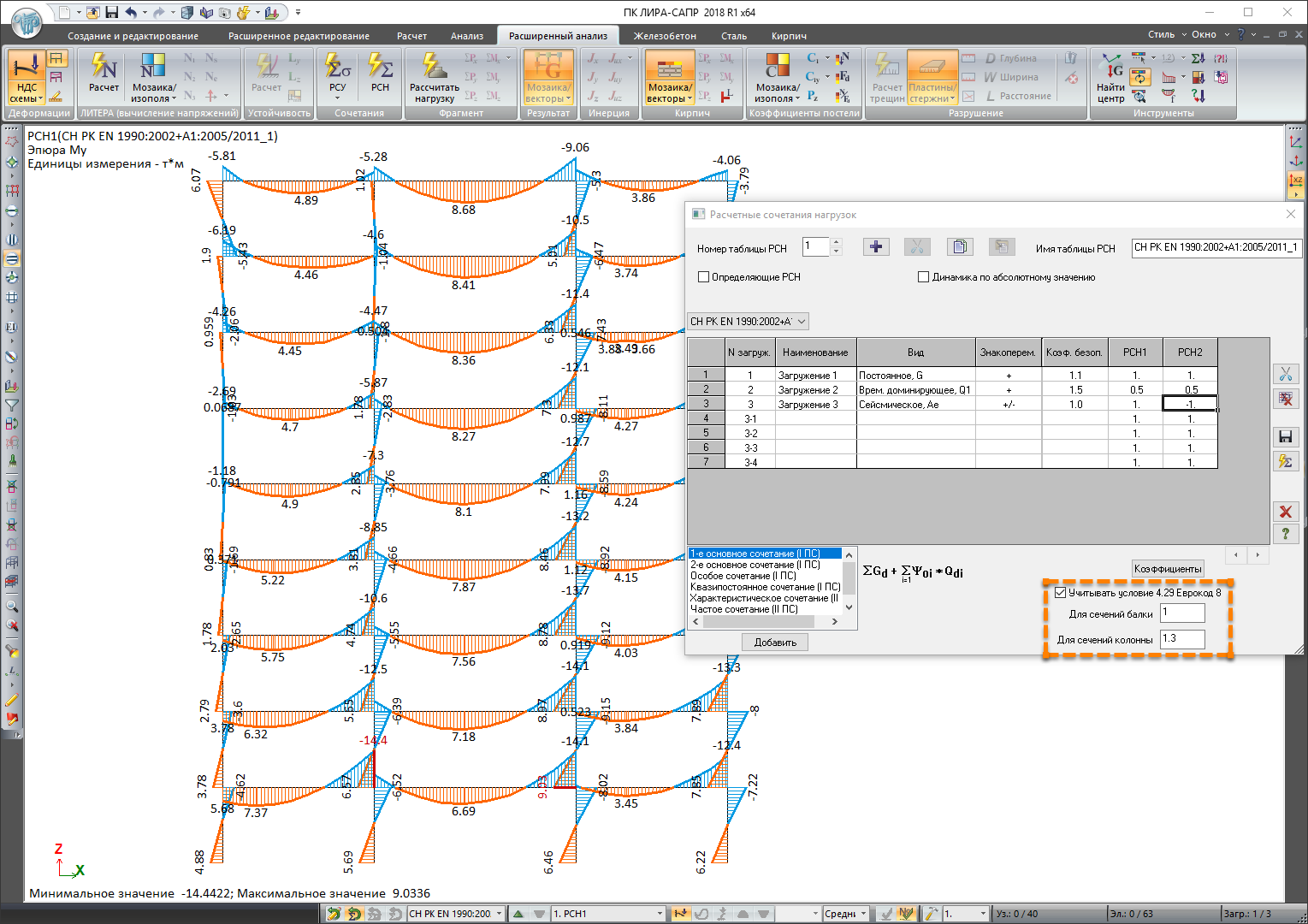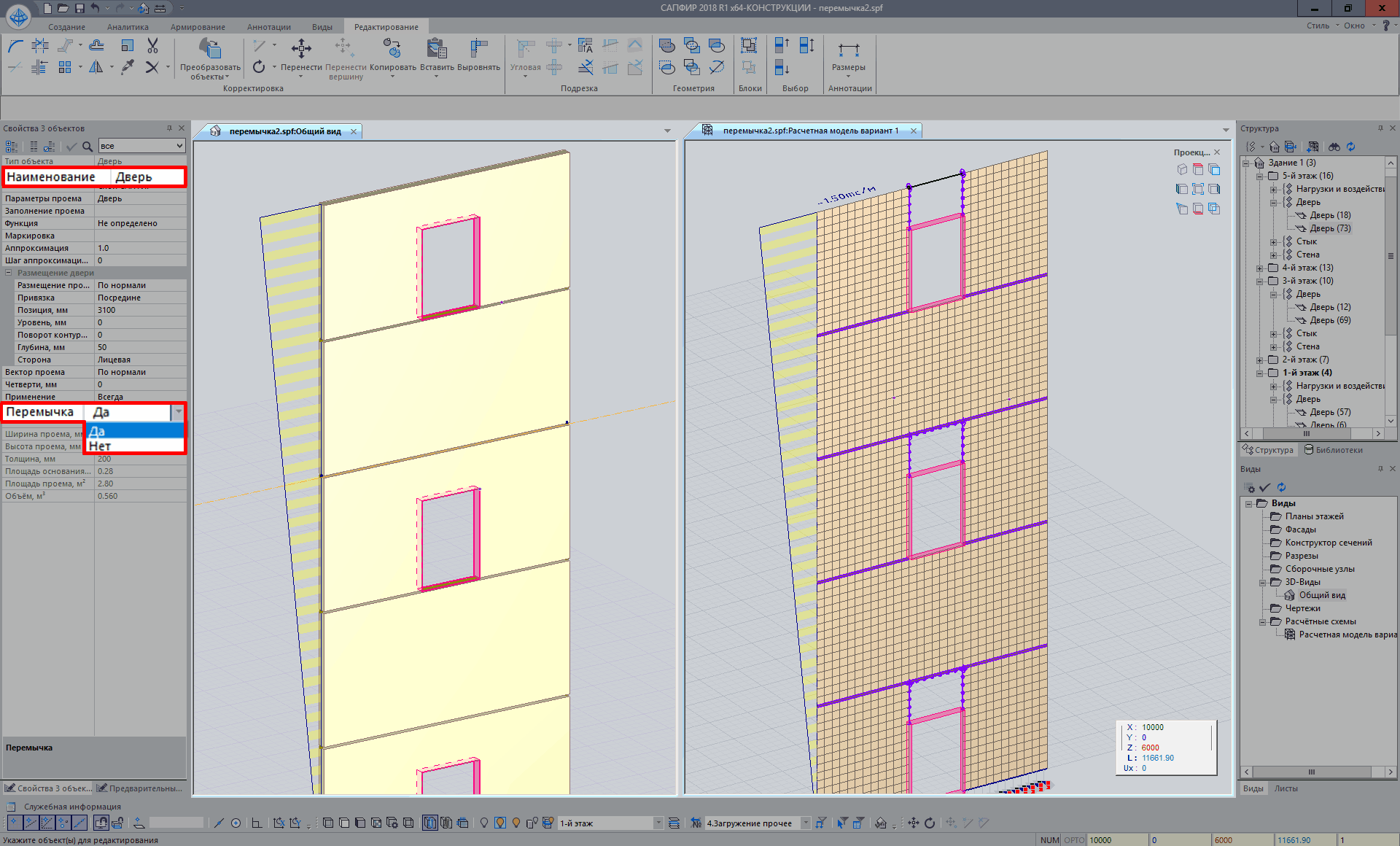Structural design software
LIRA-SAPR 2018 new features
The software for structural analysis and design, simulation of the life cycle of building structures
Interoperability - components of BIM technology
Two-way integration with Autodesk Revit is presented. It includes:
- sets of families and tools for generation of analytical model in Revit for structural engineering, the model is as close as possible to LIRA-FEM design model;
- option to transfer analytical model from Revit to LIRA-FEM for strength analysis;
- option to transfer selected reinforcement from LIRA-FEM to Revit for design of RC bearing slabs, walls, columns and beams;
- a set of tools for graphic visualization and check of reinforcement, the tools are familiar to LIRA-FEM users but they function in REVIT environment.
New system SAPFIR-Generator
In the BIM chain, a new flexible tool is introduced - system of visual programming that allows the user to parametrically simulate buildings and structures of arbitrary shape. This system represents advanced technologies for generating models of structures. It is a graphic editor for algorithms (sequence of actions), the SAPPHIR-3D simulation tools are used in it. This new system demonstrates the current trend in the development of simulation technologies: evolution from text file, graphical environment and up to visual programming.
Primitives generated in SAPFIR environment or data imported from other CAD programs may be used as the input data for SAPFIR-Generator:
- 3D shapes (surfaces) in *.obj format;
- geometric primitives in *.dxf format (points, lines, polylines, contours).
When the input data is modified in other CAD programs (surface shape of *.dxf file are modified), the model in LIRA-CAD is updated automatically.
Download files of this example:
SAPFIR-Generator. Dynamic interaction with AutoCad
Plugin for Grasshopper + Rhinoceros
Plugin for Grasshopper + Rhinoceros is developed. Plugin offers a solution for transferring basic geometric shapes to full BIM elements.
This tool enables Rhino, Grasshopper and LIRA-CAD work together in order to create and manage the BIM model through visual interface of Grasshopper scenarios.
Plugin consists of a set of components, such as generation of beams, columns, walls, slabs and surfaces for integration with SAPFIR. They are available on Grasshopper toolbar, on ‘SAPFIR’ tab. Tools of this plugin together with Grasshopper tools provide generation of 3D models in LIRA-CAD. When the model is edited in Grasshopper or Rhinoceros, then model in LIRA-CAD is automatically regenerated.
Tekla Structures–LIRA-SAP–Tekla Structures
Two-way integration between LIRA-SAPR 2018 and Structural design software for steel Tekla Structures 2017i. Plugin for work with Tekla Structures 2018 will be added in future version of the program (R2).
New plugin is enhanced with the following options:
- nonstandard types of sections are transferred to design model (from Tekla Structures) as stiffnesses from the Cross-section Design Toolkit module;
- reinforcement selected in LIRA-FEM and arranged in Design of RC structures is now transferred to structural elements of Tekla Structures;
- more options to transfer main and additional reinnforcement to Tekla Structures through the use of tools ÇMesh Area and ÇMesh Bars by Area.
Converter Tekla Structures–LIRA-SAPR–Tekla Structures enables the user to carry out complete analysis and design of steel and RC structures.
LIRA SAPR company is an official partner of Tekla.
Unified intuitive graphic environment
Direct3D technology - graphics speed-up
Presentation of design models is based on Direct3D technology. The memory of video adapter is used. Optimized algorithms for generation of images are developed for fast and high-quality visualization of large-scale design models. In real time mode it is possible to preview and rotate the model that contains several millions of elements. LIRA-FEM program becomes more easy-to-use when the user works with large problems (design models) at the expense of optimum useage of computer hardware.
Previous visualization system is saved, several algorithms are optimized and there is an option to switch between available methods of model presentation.
New tools
To evaluate input data, new modes of mosaic plots are provided for assigned element properties (such as stiffness, materials, pilot reinforcement). Now to select all objects with similar properties, just click the colour palette.
New option to edit (in interactive mode) range colours of the current colour palette for contour and mosaic plots. New mode when you could edit colours for colour palettes of reinforcement (number of ranges is increased up to 32).
To make the work with StB more convenient, now you could filter the list by several property columns and collapse them according to selected options.
New option to save applied frags of drawing to the user-defined set, so the settings for visual presentation of design model will be at hand.
More options in the filter for selection of structural blocks.
Panels of ribbon user interface as well as menus and toolbars in classic interface are modified; new commands are added.
In DCL tables there is a new option 'Dynamics by absolute value'. It enables the user (in DCL analysis) to determine total values of displacements and forces for dynamic modules by absolute values of their components. If this option is not selected, then total values will be computed with account of signs. In this case, the sign of total value will correspond to the sign of max component by absolute value, and in wind pulsation–to the sign of static component.
New option to adjust the settings for current colour palette in interactive mode. To select the colour for the colour palette range, just double click certain range on the colour palette.
Loads on piers are presented in a new way, so the user could collect linear loads on foundation.
To check the loads defined with eccentricity, mosaic plot of eccentricity values on bars is available now.
For building codes based on Eurocode requirements, it is possible to generate user-defined combinations.
Assigned types of Pilot Reinforcement (PR) may be used to describe the stress-strain diagrams for reinforcement and to arrange reinforcement for nonlinear stiffnesses. With this option, it is much easier to prepare design model to physically nonlinear analysis.
To compute stresses at any section of bar according to static/dynamic analyses, forces/DCF/DCL may be now transferred to Cross-section Design Toolkit module with the interactive tables of the Report Book. Number of rows is not limited.
Tools to define and analyse bar systems with account of warping
2D and 3D bar systems may be analysed in constrained torsion, with account of warping in cross-sections of bars. So, you could carry out analyses of thin-walled bar structures by Vlasov theory.
To define and analyse design models with account of constrained torsion, the new model type (6) is used. In this case, nodes of design model have seven degrees of freedom: three translations along coordinate axes (X, Y, Z), three rotations about these axes (Ux, Uy, Uz), and translation of warping W.
New finite element of thin-walled bar (FE type 7) is provided. For FE 7, stiffness is either defined numerically (including warping stiffness E*Iw) or selected from the steel table. The seventh degree of freedom is considered when you impose restraints, coupled DOF, assign hinges to bar elements.
New types of loads are introduced: concentrated bimoment at node and on bar, bimoment uniformly distributed along bar, defined warping of cross-section.
Output data for thin-walled bar structures are presented graphically: as mosaic plots for warping at nodes of design model or diagrams and mosaic plots for bimoments in elements of the model.
When collecting loads on fragment, bimoment is added to the list of reactions at nodes of the model.
For dynamic analysis, you will also obtain mosaic plots for bimoment of inertia.
FEM-solver
NonLinear Engineering Design 2 (NL Engineering 2)
New variant of NonLinear Engineering Design system is developed.
Stiffness parameters that correspond to ‘characteristic load case’ are computed based on step-type method for physically nonlinear structural model, where elements already have pilot reinforcement. Analysis on all further static and dynamic load cases is carried out at linear-elastic state with option to calculate DCF and DCL. In this case, stiffness parameters of elements correspond to shear modulus of elasticity computed at the last stage of analysis of nonlinear model.
As analysis results on ‘characteristic load case’ are included into DCF and DCL, then ‘characteristic load case’ should contain dead and live loads with coefficient 1. With such approach, it is possible to use the mode ‘NonLinear Engineering Design 2’ for analysis and simulation of erection process, analysis of large panel buildings (platform joints), etc. When erection is simulated, characteristic load cases may be defined at stages. ‘NonLinear Engineering Design 2’ is built on the idea of simulation of load history (step-type method) in physically nonlinear analysis by standard method.
Pushover analysis (for different building codes)
Pushover analysis is provided for multimass design model. Pushover analysis (response spectrum method for bearing caspacity) is the static nonlinear analysis in which vertically loaded design model of the structure is subjected to monotone increase in horizontal earthquake load with the check of horizontal displacement. Inertial forces (that are computed in linear analysis and correspond to the mode shape of natural vibrations with max modal mass) are considered as the earthquake load for nonlinear analysis.
Summing up mode shapes with the same frequencies
Summing up mode shapes with the same frequencies
- the structures symmetric in plan;
- the same structures located at separate foundations or common foundation.
After such summing up, one mode shape is generated for further analysis. It facilitates visual evaluation of analysis results in VISOR-SAPR module and, most importantly, it provides more correct summing up of mode shapes in calculating design combinations of loads (DCL) and design combinations of forces (DCF).
Analysis of bar systems with account of warping effect
Within this analysis, the following options are realized:
-
New model type 6 (X,Y,Z,UX,UY,UZ,W). In this case, nodes of design model have seven degrees of freedom (DOF): 3 translations (X,Y,Z), 3 rotations (UX,UY,UZ) and new DOF - warping (W).
- For this DOF you could impose restraints, coupled DOF, hinges (for bars), loads and initial displacements.
- For this DOF in analysis results you will obtain displacements, mode shapes, buckling modes, reactions (load on fragment), masses and inertial forces.
- New FE 7 (thin-walled bar). Stiffness for this element may be defined with numerical description ‘FE 7 numerical’. In description of this stiffness there is new parameter — warping stiffness (EIw). When you assign stiffness from the steel table, warping stiffness (EIw) and displacement of shear centre (RuY and RuZ) are calculated automatically.
- In the output data for FE 7 you will obtain the same set of forces as for FE 10 + new type — Bimoment.
- Loads with eccentricity. It concerns not only FE 7 but FE 10 as well. For concentrated, uniformly distributed and trapezoidal load you could define eccentricity relative to the gravity centre of the element. Eccentricity creates additional twisting moment. This moment generates additional mass if consistent mass matrix is selected. Additional twisting moment is computed relative to the shear centre by formulas Mk=Pz*(DY - RuY) and Mk=Py*(RuZ - DZ), where DY, DZ — eccentricity of force, RuY, RuZ — displacement of shear centre of an element relative to the gravity centre.
-
New loads:
- Bimoment at node.
- Defined warping at node.
- Concentrated bimoment on bar.
- Uniformly distributed bimoment on bar.
Boundary finite elements of soil half-space
New finite elements that simulate behavior of 3D soil half-space in dynamic loads:
- FE 68 - triangular element;
- FE 69 - arbitrary quadrilateral element.
These elements simulate behaviour of rejected part of 3D soil half-space when considering limited 3D soil.
Earthquake analysis
In addition to 28 modules for earthquake analysis according to different building codes (SNIP II-7-81/Russian Federation, NF P 06-013/France, ASCE 7.05/USA, Eurocode 8, RPA 99/Algeria, etc.), the following modules are added:
- earthquake analysis acording to SNIP KP 20-02:2017 "Earthquake engineering" (building code of Kyrgyzstan).
- earthquake analysis acording to SP PK 2.03-30-2017 "Construction is seismic areas of Kazakhstan" (Kazakhstan).
RC structures
Pilot reinforcement
New technology is introduced: parameters of discrete reinforcement generated after linear elastic analysis are assigned to bar and plate elements. These parametes include diameters of rebars and reinforcement pattern in the section. Generated parameters may be applied to analysis of problems with engineering, physical and geometrical nonlinearity. Parameters of discrete reinforcement may be user-defined as well.
From selected reinfrocement in elements of the model and current colour palette of analysis results, new types of Pilot Reinforcement (PR) may be generated and assigned automatically.
Analysis of reinforcement in cast-in-place and precast slabs with blockouts
New technology for analysis of reinforcement in cast-in-place and precast slabs with blockouts is realized according to STO NOSTROY 2.6.15-2011. This technology (suggested by our clients and realized in LIRA-SAPR 2018) opens new horizons in simulation for engineers that design effective buildings and structures.
For our company, this is new positive experience in the implementation of advanced technologies. It opens a new direction - development of program on request.
Concrete sections with fibre-reinforced polymer (FRP) bars
In LIRA-SAPR 2018 you could analyse RC sections with FRP bazalt bars according to DSTU-H B V.2.6-185:2012. Analysis of reinforcement is carried out according to DBN B.2.6-98:2009.
In analysis of reinforcement, the following classes of PRB bars are used: ANPB 800 and ANPB 1000, they may be used only as longitudinal reinforcement. In this case, steel reinforcement is used as transverse one.
Analysis of PRB bars is provided for the following types of standard sections: rectangular bar, T-section with flange at the top, T-section with flange at the bottom, I-section, box, ring, circle, cross, angles, asymmetric T-section with flange at the top, asymmetric T-section with flange at the bottom.
Analysis of PRB bars is also available for plate elements: shells, slabs, wall-beams.
The following building code is supported: SP 63.13330.2012. Concrete and reinforced concrete structures. General notes. Annex L. (R2)
New options
When you compose design combinations of loads (DCL) for building code CH PK EN 1990:2002+A1:2005/2011 (Kazakhstan), it is possible to edit values of bending moments in reinforced concrete beams and columns according to clause 4.29 Eurocode 8. You could edit forces only for earthquake loads included into DCL.
Enhanced analysis of reinforcement. Unlike the previous versions, on the RC ribbon tab (mode 'Design'), now it is possible to start analysis of reinforcement for all required design options and define all unique parameters for analysis.
For DBN B.2.6-98:2009, in strength analysis of inclined sections in shear force, an alternate analysis is provided; it is carried out according to EN 1992-1-1:2005.
Punching shear analysis of slabs on soil foundation
Transverse reinforcement may be analysed at zones where column/pylon is supported with foundation slab/grillage and where column is supported with inserted floor. If soil foundation is attached to design model, punching shear force is unloaded with reactive soil pressure. For evaluation and illustration purposes, in SAPFIR program you could present contour that was applied in collecting reactions from elements of foundation slab/grillage.
Punching shear contours may be generated in SAPFIR program and in VISOR-SAPR module as well. Punching shear contours are generated automatically depending on geometry of column section, slab thickness, dimension to longitudinal reinforcement, and with account of rules for generation near the openings and slab edge.
After analysis you will obtain computed punching shear forces, area of necessary transverse reinforcement and safety factor. Output data is presented in graphic and tabular formats.
Steel structures
Analysis and design of steel structures according to Eurocode 3
LIRA-SAPR 2018 supports the following building codes for analysis & design of steel structures:
- EN 1993-1-1:2010 Eurocode 3: Design of steel structures - Part 1-1: General rules and rules for buildings, and
- ÅN 1993-1-2:2005+AC 2005 (E) Eurocode 3: Design of steel structures. Part 1-2: General rules. Structural fire design.
Above-mentioned building codes and realized for selection and check for a large number of cross-sections of solid bars.
Output data is presented in graphic and tabular formats.
Results of the strength checks are presented as utilization ratio of bearing capacity according to all checks stipulated in building codes.
Fire resistance of steel structures according to Eurocode 3
The program has options to determine and visualize critical temperature in elements of the structure (temperature at which plastic hinge is generated). Thus, it is possible to determine bearing capacity of the structure with account of modification in material properties of steel in high temperatures.
Critical temperature is determined for the specified/selected section according to Eurocode 3, part 1-2 (Structural fire design).
Analysis results (critical temperature, °C) are presented as mosaic plot and in tabular format.
In local mode of STC-SAPR it is possible to check analysis of critical temperature in the section. This check is made by automatic preview of tables in the report where changes in bearing capacity of the structure are displayed depending on changes in temperature of steel. In the report you will also find changes in material properties and parameters of elements -slenderness ratio, reduction factors for buckling in bending and shear.
Database of steel tables in LIRA-SAPR
Updated databade of steel tables LIRA-SAPR:
- new steel tables according to valid building codes;
- existing steel tables are updated according to buildign codes;
- dimensions and geometric properties of profiles are checked for correspondence with values mentioned in building codes;
- geometric properties are checked, obvious misprints in building codes detected during the check are corrected.
With regard to analysis with account of warping in the section, methods for analysis of torsion and shear properties of the section were modified and new methods for analysis were added. Now with the help of FEM-analysis, in SRS-SAPR module (Steel Rolled Shapes) you could compute location of shear centre and torsion centre, twisting moment of inertia, warping constant, shear areas along principal central axes of inertia.
New tables of steels and steel profiles that are in use on the EU territory. The following building codes are supported: EN 1993-1-1, EN 10025, EN 10113, EN 10137, EN 10147, EN 10210-1, EN 10219-1, EN 10225, EN 10326, EN 10340.
Steel tables used in LIRA-FEM for analysis of steel structures were verified in the following way:
- Section dimensions are read automatically (besides main dimension, the program reads curvature radius, changes in flange thickness along the flange length, etc.)
- By the section dimensions that were read, in the "Cross-section Design Toolkit" module you could determine all geometric properties of the shape, including torsion and shear properties, warping moment of inertia, location of torsion centre. Step of FE mesh in analysis is determined automatically and is equal to 1/5 of min thickness of web and flanges in the shape. Time for analysis of one shape in automatic mode is about 1-2 sec.
- Missing geometric properties in the verified steel table are added with computed ones.
- In case computed properties are differ from the ones available in the steel table by more than 5%, the properties are replaced with computed ones. Number of mismatches was approximately 10-12% from total number of properties. Computed properties were considered more precise as all peculiar features of the section (rounding, variable thickness of flange, etc.) were considered in analysis.
- Steel tables that were already available in the database of SRS-SAPR module (more than 100 steel tables, 100-300 shapes in every steel table) and added steel tables (more than 20 steel tables–see below) were verified.
New tables of steel profiles according to the following building codes:
- T-sections by EN 10055,
- angle sections by EN 10056-1,
- flat bars by EN 10058,
- hot-rolled square bars by EN 10059,
- hot-rolled round bars by EN 10060,
- channel sections PFC, UPE, UPN, I-sections HD, HE, HL, HLZ, HP, IPE, IPN, UB, UBP, UC, J by EN 10365,
- hot-rolled pipes, square and rectangular profiles by EN 10210,
- cold-formed pipes, square and rectangular profiles by EN 10219,
- angles, channels, I-sections and T-sections by ASTM A 6/A 6M,
- additional profiles by ASTM A 6/A 6M according to catalogues ArcelorMittal.
SOIL system
Modulus of subgrade reaction C1 in dynamic loads
One of the main types of man-caused impacts on the geological environment are vibrodynamic loads that arise during construction and maintenance of engineering structures. Such loads may cause a change in the physical and mechanical properties of the foundation soils and influence the stress-strain state of buildings and structures. Many researchers informs about increase in deformability of soils under dynamic influences in comparison with static soils. In the new version, subgrade modulus C1 in dynamic loads on foundation is calculated by Savinov's formula.
To carry out calculation, in the table with soil properties one new property is added: elastic constant Ñ0
Documentation
Report Book
New updatable tables of input data for documentation are introduced:
- tables with properties of RC and steel materials available in design model;
- table of hinges where you will see location of hinges in design model, their directions and stiffness values;
- tables with parameters of piers for collecting of forces; tables describe geometry of the piers.
The following updatable tables for documentation of analysis results are added:
- tables of fire resistance in steel structures according to Eurocode (ÅÑ3);
- tables of analysis results for bar systems with account of warping effect, such as bimoments on elements and warping at nodes of the model;
- tables with forces acting on piers from applied load cases, tables of design combinations of forces (DCF) and design combinations of loads (DCL);
- tables of analysis results for the check of specified reinforcement.
For strength analysis of large panel buildings, new updatable tables of input data are available for geometric properties of piers. In the mode of analysis results, this table is united with forces in piers by load cases/DCL/DCF.
It is possible to automatically save tables with input and output data to the *.csv format.
This module in version 2018 enables you to:
- generate geometry of arbitrary multi-material solid, thin-walled and combined sections of bars with complex and simple, nonstandard and standard shapes;
- define physical and mechanical properties of materials available in the section in order to determine stresses that nonlinearly depend on strains;
- compute stiffness parameters of the whole section and its components and export these parameters to VISOR-SAPR module;
- determine stress-strain state of the whole section in defined forces or forces imported from VISOR-SAPR module;
- define stress-strain diagrams for concrete of different grades and reinforcement according to SP 63.13330.2012, SNIP 2.03.01-84* and Eurocode 2;
- define stress-strain diagrams for flats and steel shapes;
- define stress-strain diagrams in tabular format;
- visualize stress-strain state as mosaic plots, contour plots and diagrams for stress;
- animate stresses in step-type increase of defined forces.
Large panel buildings
New tools
Previously developed Large panel buildings module enables you to generated design models, analyse them and evaluate analysis results in LIRA-FEM environment. This module is now enhanced with new options.
For monolithic and panel buildings, the zone above the window and door openings may be automatically simulated as bar (lintel). Section of bar is computed automatically and presented only in analytical model.
When arranging joints, it is possible to save gaps that exist in the model between panels.
Joints and their labels may be visualized on documentation views (plans and sections).
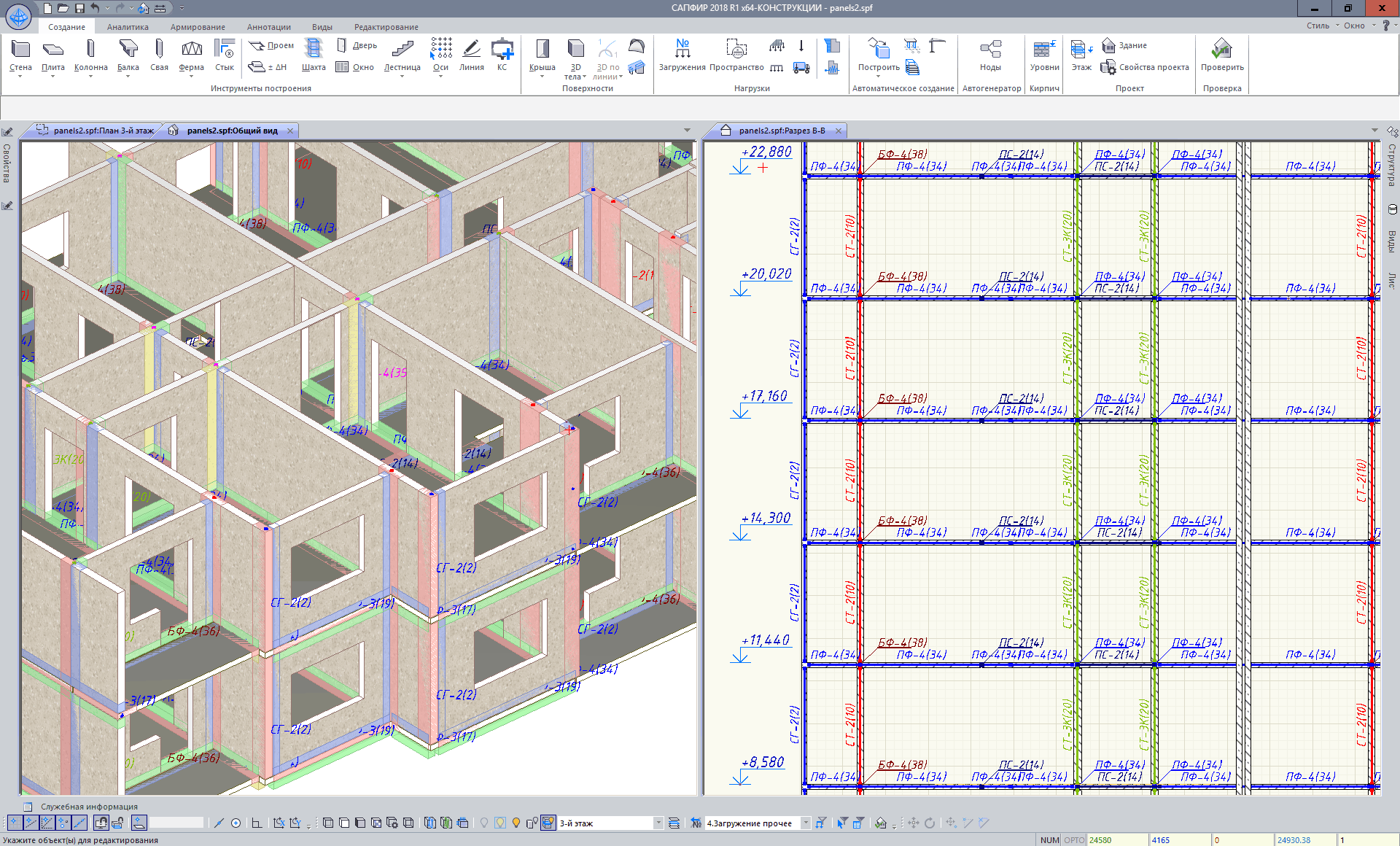
Within the same joint the user could define connecting pieces of different stiffness and that connect different number of panels. For illustration purposes, connecting pieces are presented in different colour.
List of joints includes all labels of joints available in the model. Components of joint (summary) and number of copies of every label in the model are provided. The list may be used to edit properties for selected label of joint.
Joints may be labelled automatically according to selected properties: diagram of panel connection, structural presentation of joint, variant of arrangement and settings for connecting pieces, length of joint.
Models (walls, slabs, columns, beams, axes) are aligned automatically. This option improves quality of the model by aligning objects parallel to coordinate axes. Coordinates of elements are reduces to modular grid.
Places where panels are not connected with joints may be visualized.Enhanced algorithm of automatic arrangement of joints, etc.
LIRA-CAD
New options
The system response speed during model generation is increased when you work with large number of objects (about 5000). In SAPFIR 2017 and earlier versions, when you worked with large model you could not complete generation of objects up to the time when the Project Structure was updated. In version 2018, this procedure is separated in a parallel process and generation of object now does not depend on updating the Project Structure.
New option to limit the visible volume (view cube). Part of the model outside the cube limit is visually cut off by six planes and becomes invisible. You can automatically set the visible volume according to dimensions of the active storey (with CTRL) or to dimensions of the selected objects (with SHIFT). The edges in sections of structural elements are displayed with hatching corresponding to materials assigned to them.

Now you could define the value of the constant component for loads that are specified as a property of slab. For each of the loads, you could select the load case where it is included. By default, 3 load cases are now generated for slabs: dead loads, live loads and short-term loads.
For capitals and isolated footings it is possible to define different values for width and length of the stage.

New tools are implemented for editing procedure:
- cut objects and remove the inner part (punching shear contour, lines);
- cut off objects along a specified line (punching shear contour, lines, beams and analytical model of beams).
New functions are added for documentation:
- automatic generation of a leader line for small dimensions that do not fit between trick marks;
- semi-automatic selection of a quadrant for placing a leader line with the object label.
The SAPFIR program is adapted to work with high-resolution monitors UHD or 4K. All dialog boxes are adapted; new, larger set of icons for all tabs is introduced; icons on the toolbars are increased. With such adaptation of the interface, you could use both 4K monitors and standard FullHD.




